|
RESULTS AND DISCUSSIONS
Algae have proliferated in almost all surface water bodies in the city. This is evident by the green scums and thick algal blooms that is a very common occurrence in urban waters as shown in figure 1. The use of algae in nutrient removal in wastewaters is not new and has been known from 1950’s (Oswald et al, 1957) in wastewater stabilisation (oxidation) ponds or raceway algal ponds (Hoffmann 1998). Wastewater treatment is a major challenge especially in developing nations. Most of the wastewaters are being generated in the rapidly urbanizing cities as Bangalore. In the city most of the C released into the sewer system and degraded anaerobically at different environments and subsequently decomposed aerobically during its flow periods in open sewers and storm water drains (Mahapatra et al., 2011b,c). The mean TOC values were ~160 mg/l and TN values were ~55 mg/l at different sampling locations in the three valleys. The TOC and TN influx into the lakes as Bellandur and Varthur lakes ranged 40-160 mg/l and 65-23 mg/l respectively. Such high C and N values in sewage are responsible for a higher emission generated from anoxic conditions in the city wastewaters. The GHG are contributed during the flow of the sewage through the UGD’s, during the time of treatment at WWTP’s and during their flows in storm water drains and in the lakes of the city. It has been estimated that negligible GHG (especially methane) is being captured or transformed to non-reactive forms in the city leading to higher quantum of emissions accounting to 172 tonnes of N2O/yr; 3,10,795 tonnes of CH4/yr. The CO2 being generated during the bacterial activities in the WWTP’s though non-fossil in origin, but contributes significantly to the city’s existing CO2 load and individual’s wastewater C-footprint. However in the water bodies due to dense algal growth minimal CO2 is absorbed during the day, but CO2 might be released during night due to respiration.
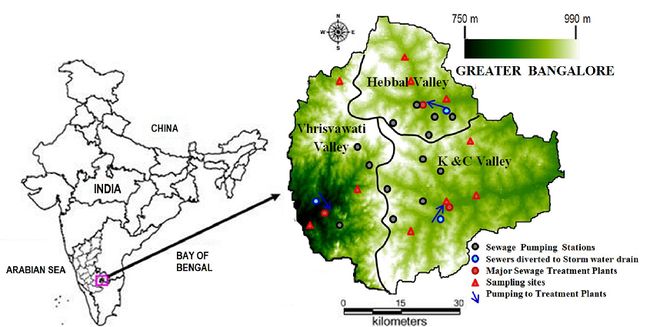
Figure 1. Study Area: DEM showing the sampling locations valleys and the treatment units in Greater Bangalore
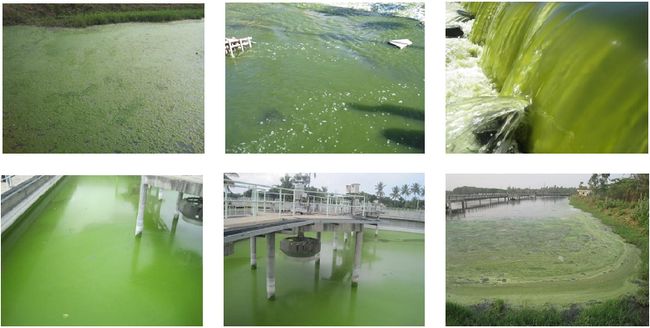
Figure 2. Algal Scums in storm waters, lakes and in treament plants in Bangalore
There are ~14 wastewater treatment units in the city that could partially treat the wastewaters up to secondary levels. However the limiting nutrients as N and P are left behind in the final effluents of these treatment units (Mahapatra et al., 2011a). Most of the N present in the system is in the form of Amm-N (~45 ppm) that can be potentially up-taken and immobilised in algae (Mahpatra et al., 2011c). However the nitrate values were very less 1-5 mg/l in city sewers and ~1 mg/l in lakes (Mahpatra et al., 2011b). In a mass balance approach as high as 80 % of the total N present in such wastewaters is in the form of Amm-N. The N budget in the water bodies revealed a substantial amount that was not accounted (~40%). This could be due to ammonia volatilisation or denitrification or could be due to ANAMOX (anoxic ammonia oxidation). The algal comprise of ~5-8% N in their biomass (Mahaptra et al., 2011b). Algae have been tested in the laboratory and in the ambient conditions for its efficiency in removing N from wastewater and thence are key players for nutrient remediation particularly during the secondary and tertiary treatment phase of wastewater. The laboratory studies showed ~92 % of amm-N removal and 88% of TN removal in just 8 days batch cultures in wastewaters.
The P removal efficiencies in algae-based treatment systems are very efficient compared to chemical treatment (Hoffmann 1998) Though there was a net retention of soluble P in the effluents of the lake units that can be attributed to the re-suspension of the P from the lake bottoms due to anoxia (Mahapatra et al, 2011a). The laboratory based studies on algal P uptake showed 80% of orthophosphate removal and ~72% of TP removal (Reported elsewhere and yet to be published). As P is in excess, a higher retention of wastewaters would allow total algal capture of P through luxury P uptake. Figure 4 elucidates the accumulation of polyphosphates in the algal solids. The SEM image shows significant P accumulation (~3% by wt.) as shown by the P peak through the electron dispersion XRD data of dried algal cells.
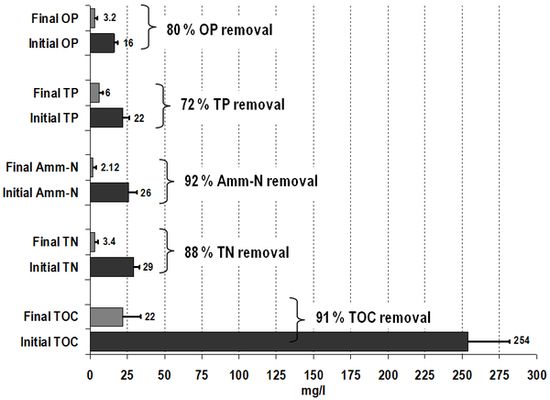
Figure 3. Laboratory studies on nutrient removal by wastewater algae
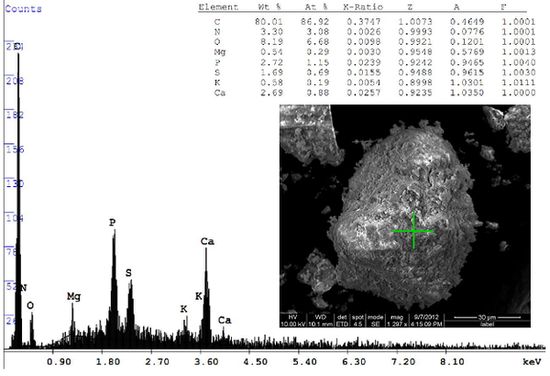
Figure 4. SEM image: Polyphosphate accumulation in algal solids
Significantly high rates of oxygen generation from photosynthetic algae (6-28 ppm) in the present study can offset the requirement of mechanical aeration systems which has a high initial and operational costs (Mallick, 2002). Oxygen in the dissolved forms in treatment units enhances the rate of heterotrophic bacteria (faster decomposition) to remove organics and other ionic substances and treat the wastewater (Munoz and Guieysse, 2006). Furthermore the algal treatment systems enhances the sustainability of the treatment systems by avoiding the generation of bi-products and additional pollutants like sludge thereby closing the loop for efficient nutrient recycling. The biomass in these ponds are rich in nutrients that can directly applied to land as low-cost fertilisers, as animal feed (Munoz and Guieysse, 2006) or can be made to use in many different ways that satisfies our biofuel needs. Thus algae have the abilities to completely tap the nutrients in the wastewaters with optimal feed rate and proper growth conditions at the same time abate GHG emissions. The algal based pond technologies are advantageous over conventional ones as they are simple, cost effective less energy intensive, thus best suiting the developing countries as India.
The urban wastewaters are enriched with very high concentrations of nutrients as C, N and P compared to the other growth media. The major fraction of N is in the form of ammoniacal–N sustains many algal species mostly dominated by Chlorophyceaen members comprising Chlorella sp., Monoraphidium sp. and Chlorococcum sp etc. Contrary to this there are many studies that highlight the lethal effects of higher Amm-N on algae due to ammonia toxicity (Ip et al., 1982; Konig et al., 1987; Wrigly and Toerien, 1990). The algal communities in urban lakes at Bangalore were responsible for about 45% N removal and 60% C removal (Mahapatra et al., 2011a). Similar findings were also found in earlier nutrient uptake studies in chlorophytic algae as Chlorella sp. and Scenedesmus (Ruiz-Marin et al., 2010) growing in wastewater lagoons and advanced algal ponds (9, 40). Chlorella sp. and Scenedesmus sp. has been studied widely as these species grows well in sewage effluents (Yujie and Zhang, 2011). These species show a very high (>80%) nutrient removal efficiency and in many instances results in almost complete removal of ammonia, nitrate and total P from secondary treated wastewater (Ruiz-Marin et al., 2010). Euglena sp. has been recently characterised in wastewater treatment ponds in India (Bangalore and Mysore, Karnataka). With a higher biomass productivities in raw sewage they grow heterotrophically in dark and have a mixotrophic mode of nutrition with a variable C and N (NH4-N) uptake at growth rates of 155 mg/l (unpublished data) compared to 73 mg/l under phototrophic conditions for growing Chlorella minutissima in 10days (Bhatnagar et al., 2010). These experiments prove euglenophycean members as better nutrient assimilators in raw wastewater systems. The algal sp. that have been characterised to inhabit wastewaters in different physico-chemical conditions have been packaged as a module that can be integrated to STP effluents for total nutrient removal (to be published elsewhere).
The transitions in the biochemical compositions were identified using ATR-FTIR spectroscopy and the band assignments following Dean et al, (2010) to observe the cells at wave numbers between 1800 and 800 cm-1. With a resolution of 2 cm-1 wave number and with 64 scans. The periodically harvested and dried algal biomass showed peaks at ~1,740 cm-1 due to C=O stretching in Lipids (esters of fatty acids); ~1,650 cm-1 C=O stretching in Proteins (Amide I); ~1,540 cm-1 N-H Amides of proteins (Amide II); ~1,398 cm-1 CH3 and CH2 of Proteins (Amide III); ~1,240 cm-1 P=O Phospholipids, DNA and RNA; 1,200-1,160 cm-1 C-O-C in Carbohydrates and Polysaccharides and ~830 cm-1 C=N (ring) in nucleotides and chlorophyll pigments. The Chlorococcum sp. grown in wastewater showed higher lipid content at the end of the batch cycles due to nutrient deprivation as can be observed in the shifts of the biochemical pools at the initial and the later stages of the cycle.
The algae (chlorophycea) isolated from the wastewaters from Varthur lake were made to grow in outdoor cultures in open tub reactors (bench scale, batch reactors 10 litres volume) The daily growth of the algal species were monitored and lipid measurements showed a hype in lipid content in the stationary phases of the culture experiment and was confirmed with ATR-FTIR studies that showed a very prominent band at ~1740 cm-1 (lipid) in the Vibrational spectra (Figure 5). Ultrasonication was employed for cell disruption and the lipid extraction was carried following the methods of Bligh and Dier (1959). The total lipid content during the experiment varied from 24.5-28.4% of dry algal biomass. The mass productivity was observed to be 133 mg/l/d from the open tubs with an area productivity of ~10 g/m2/d.
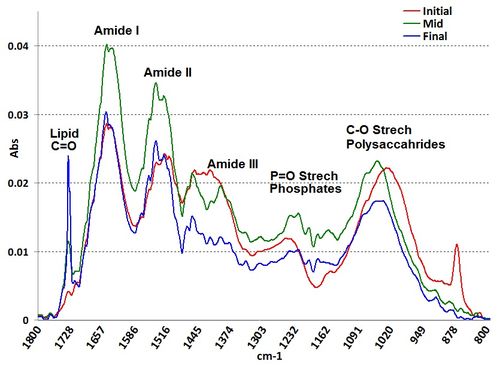
Figure 5. FTIR bands for the compositional analysis of algae during its cultivation
Note: The red, green and blue curves indicates the spectra of the algal cells during the initial, middle and final stages of the cultivation
The capability of algal communities to thrive under acute wastewater conditions, as has signified the potential of these nutrient rich resources as suitable sustainable natural growth medium for biofuel feedstock. These algal communities can stock significant amount of lipids in the cell. The nature and type of lipids (saturates, unsaturates, polyunsaturates and glycol/phosphor lipids or TAGS) and the quantity of lipids produced (max-80% of the cell dry weight) depends on the nature of species and the algal growth conditions (Ramachandra et al, 2009; Griffiths and Harrison, 2009). The unlimited nutrient supply in wastewaters would result is high algal cell densities and higher lipid productivities.
The present studies undertaken to screen the algae with highest lipid content showed Chlorococcum sp. which had the highest lipid content (~28 %) followed by Euglena sp. (~24%), Phormidium sp. (~18%) and Microcystis sp. (~8%) (Reported elsewhere, yet to be published). Algae mostly grown on municipal wastewater and the biomass of the cells ranged from 20–35 mg/l/d and the wastewater produced each year desired to be used for the entire year would yield the algal biomass of 16-28 tonnes/ha/yr to produce an estimated lipid yield of 3260-3830 L/ha/yr (Chinnasamy et al., 2010). The batch culture growth studies in municipal wastewaters of Chlamydomonas reinhardtii revealed higher growth rates (100% centrate wastewater) with a lipid content of ~17% on a dry wt. basis (Kong et al., 2010). The same cultures being transferred to bio-coil showed a consistent growth in wastewaters with increased lipid content of 26% on a dry wt. basis and biomass productivity of 2 g/l/d and an estimated lipid yield of 0.505 g/l/d coupled with adequate nutrient removal (Kong et al., 2010). The lipid content from mixed algae cultures, isolated from sewage treatment ponds, grown in anaerobically digested dairy manure wastewater in outdoor batch cultures showed a leap in lipid accumulation In a week (14% to 29%) with an estimated lipid productivity of 2.8 g/m2/d (Woertz et al., 2009).
The gas chromatography and mass spectrometry (GC-MS) analysis of the fatty acid methyl esters (FAME) showed a higher content of important fatty acids having desirable biofuel properties (Knothe, 2006) with major contribution by the unsaturated fatty acid (UFA) oleic acid (C18:1; 42%) followed by palmitic acid (C16:0; 27%) followed by stearic acid (C18:0; 11%) and linoleic acid (C18:2; 6%) comprising of 86% of the total fatty acid constituents (Figure 6). During the end of the batch cycles, these algal species were auto-flocculated at the top of the cultures making the harvesting easier and faster for algal biomass and oil quantification.
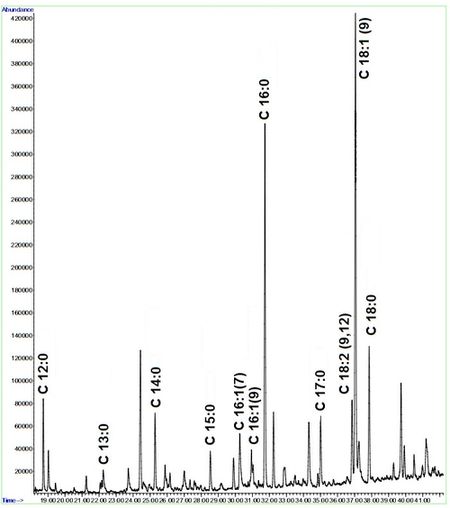
Figure 6. Chromatogram of the FAME present in Chlorococcum species.
*The peaks indicating the abundance (concentration) of the fatty acids
The use of enormous wastewater generated daily could offset these nutrient and CO2 demands. The urban lakes in Bangalore are rich in nutrients fed from domestic sewage and have a very high and healthy aerobic bacterial microflora that generates ample CO2 through respiration that can be subsequently utilised by the micro-algae (Mahapatra et al, 2011a) Similar findings are also observed in earlier studies (Munoz and Guieysse, 2006). The wastewater systems provide a year round availability of nutrients for a synergistic growth of algal-bacterial symbiotic systems degrading wastewater. The manmade lagoon system removes the burden of land area requirement at present to grow algae for biofuel requirements though in future such algal systems can be integrated to mechanised WWTP’s. Bangalore generates >1200 MLD of wastewater and the studies in one of the catchment (K and C Valley) that draws ~500 MLD reveal satisfactory treatment of wastewater through natural algal growth. With an average efficiency of ~55% nutrient removal such systems can be optimised and made sustainable by careful feed rate management and optimal detention time. The average algal cell densities found in these systems are of the order of 105-106 cells/ml. That gives biomass productivities of ~10g/m2/d. The nutrient loads were 90-120 mg/l TOC; 75-90 mg/l TN and 20-40 mg/l of TP in the waters of the catchment.
The average annual influx of nutrients amounts to 20,000 t TOC/yr of, 14,600 tTN/ yr of and 5,475 tTP/yr. With such enormous nutrient loads a number of algal species thrived in such conditions. The annual biomass generation for Bellandur lake (365 hac) yields roughly 13,000 t algal biomass/annum. Out of these if 40% is harvested for lipid extraction, then it still yields ~5000 t algal biomass/yr. Now considering the an average lipid content of 20%, 1000 t of lipid can be extracted from this water body annually. Similarly 640 t algal lipid/yr can be extracted from Varthur lake, the next lake in the cascading lake series. Likewise for the entire wastewater generated in Bangalore city the net lipid potential corresponds to >7,200 t/yr. The left out algal-biomass after lipid extraction through cell disruption and solvent treatment can be of the order of ~18000 tonnes/yr that can be anaerobically digested that would yield 7 Mm3 of methane. This adds to additional energy security from the spent biomass. The slurry left after the anaerobic digestion can be used as an excellent nutrient media for further algal cultivation or can be used as rich fertilisers which would take us a step further to stabilise our agrarian economy. In this complete loop there is no net generation of waste at the same time there is a lot of positive net energy gain that indicates sustainability. Further investigations on such type of naturally managed system and its process understanding will eventually lead to optimal wastewater treatment with efficient biofuel production.
From the earlier observations and findings it’s evident that the algal biomass can be transformed to biofuels via a wide range of technologies. But, lipid extraction from algal biomass as an oil source for biodiesel is the most promising option, particularly when there is option for cogeneration of methane from the remaining residual algal biomass (Brune et al., 2009). Albeit the lower average lipid content of algae in wastewaters, the enormous and consistent nutrient supply can results in higher biomass productivities resulting in increased lipid yields. A process flow diagram of the sustainable wastewater treatment with biofuel and nutrient recovery is proposed in Figure 7.
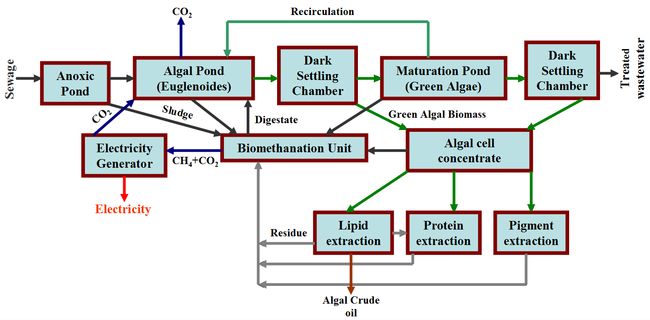
Figure 7. Process flow diagram showing a complete algal bio-refinery approach
|








